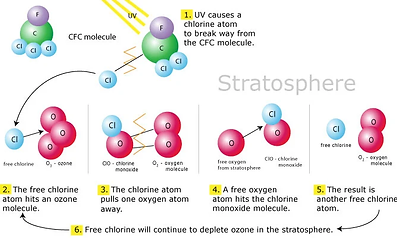
Chlorofluorocarbons
01


What are chlorofluorocarbons?
Chlorofluorocarbons or CFCs are a nontoxic, non flammable chemical containing atoms of carbon, chlorine, and fluorine. This type of chemical has a history dating back to 1928 to replace toxic chemicals commonly used for refrigeration. Other than refrigeration, CFCs are also used in aerosols, air conditioning, and insulation.
02


Why is there a hole in the ozone layer?
CFCs have a negative impact on the environment ; it affects the ozone layer, a vital layer of Earth's stratosphere which blocks off harmful UV light. When CFC molecules rise up into the atmosphere, the chlorine atoms are separated due to UV light. Then, the chlorine atoms hits a ozone molecule separating an oxygen atom to create chlorine monoxide and the oxygen we breathe. After that, an oxygen atom hit the chlorine monoxide and separates the chlorine atom, which hits another ozone molecule to repeat the same process.
03
How did the world solve the problem of the ozone layer?

In response to the depletion of the ozone layer, the world came together as one in Montreal on the 16th of September 1987 to discuss ways to save the ozone layer. This universally ratified treaty came into effect on the first day of the first month in 1989. With 197 ratifiers, the most successful climate protocol has the ambition to phase CFCs. Because of this treaty, the ozone layer is on the path to recovery
04
When will the ozone layer fully recover?
Because of the research of the ozone layer by scientists and the Montreal Protocol, the ozone layer is healing and will potentially return to its pre-1980 levels by 2060. The restoration of this important layer is slow because of the long lifespan of CFCs; the chemicals have a lifetime of 50 to 150 years. The Antarctic Ozone Hole reaches its biggest size every year from August to October during the Southern Hemisphere's Spring Season.

01


What are chlorofluorocarbons?
Chlorofluorocarbons or CFCs are a nontoxic, non flammable chemical containing atoms of carbon, chlorine, and fluorine. This type of chemical has a history dating back to 1928 to replace toxic chemicals commonly used for refrigeration. Other than refrigeration, CFCs are also used in aerosols, air conditioning, and insulation.
02


Why is there a hole in the ozone layer?
CFCs have a negative impact on the environment ; it affects the ozone layer, a vital layer of Earth's stratosphere which blocks off harmful UV light. When CFC molecules rise up into the atmosphere, the chlorine atoms are separated due to UV light. Then, the chlorine atoms hits a ozone molecule separating an oxygen atom to create chlorine monoxide and the oxygen we breathe. After that, an oxygen atom hit the chlorine monoxide and separates the chlorine atom, which hits another ozone molecule to repeat the same process.
03
How did the world solve the problem of the ozone layer?


In response to the depletion of the ozone layer, the world came together as one in Montreal on the 16th of September 1987 to discuss ways to save the ozone layer. This universally ratified treaty came into effect on the first day of the first month in 1989. With 197 ratifiers, the most successful climate protocol has the ambition to phase CFCs. Because of this treaty, the ozone layer is on the path to recovery.
04
When will the ozone layer fully recover?
Because of the research of the ozone layer by scientists and the Montreal Protocol, the ozone layer is healing and will potentially return to its pre-1980 levels by 2060. The restoration of this important layer is slow because of the long lifespan of CFCs; the chemicals have a lifetime of 50 to 150 years. The Antarctic Ozone Hole reaches its biggest size every year from August to October during the Southern Hemisphere's Spring Season.
05

What is a good replacement for CFCs?
The most common replacement for CFCs are hydrofluorocarbons ( HFCs ) . But, since HFCs are a potential greenhouse gas, they are planned to be phased under the Kigali Amendment of the Montreal Protocol. Other replacements include Carbon Dioxide and Water. Because Carbon Dioxide is the biggest contributor to global warming, water is the most eco-friendly replacement.
06

How could we use the knowledge on the ozone layer to stop climate change?
Using the knowledge on the Ozone Layer, we can create a similar protocol that phases out greenhouse gases. Also, this accord can also provide money to undeveloped and developing nations to switch to green energy, find alternatives, and to reach net zero. The best thing we can do is to raise awareness of this problem.